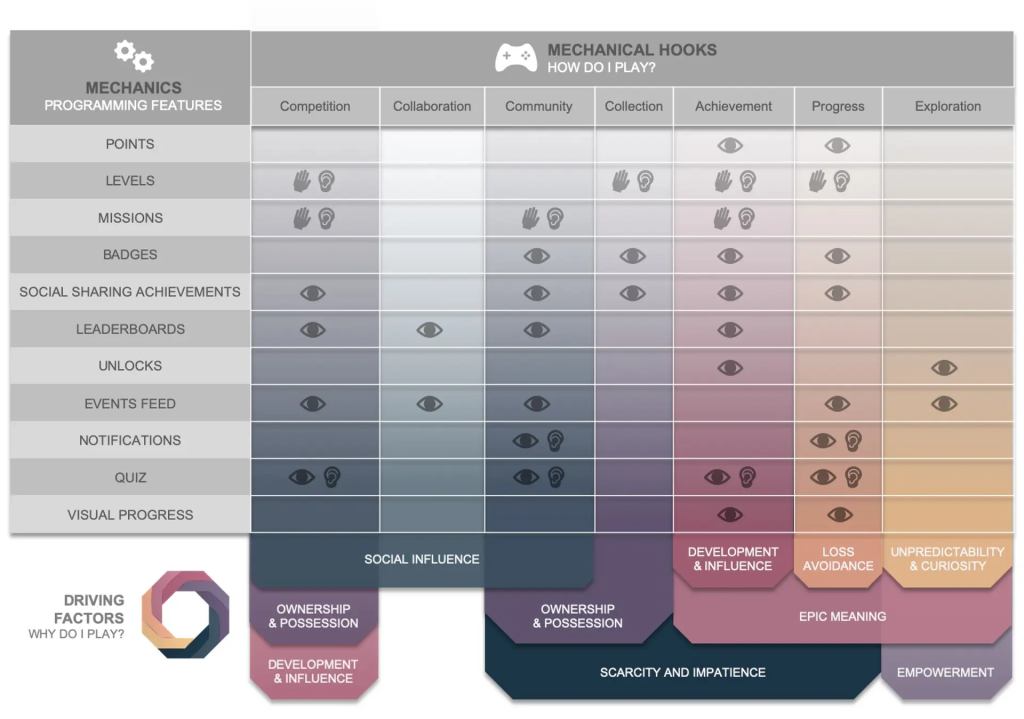“Gamification” is a term that has been popularized by the modern cultural and consumer demand of video games. It is the application of design elements (e.g. leaderboards, scoring, points) to an activity or set of activities, made popular by video games. Today, it has made its way into software programs as a way to increase engagement and productivity. Yet when we think about gamification today, we don’t generally think of its application in educational settings, let alone in the business world. After all, when was the last time Ubisoft had a press conference about how gamified Assassin’s Creed is? So what are we talking about? We’re talking about the challenge of engaging adults in professional training and development while being sensitive to their learning preferences. The reality is, it’s hard to get adult learners excited to go back to the classroom to learn something for their job. But there exists a potential for gamification to lower the barriers to learning for adults. Today’s professionals are a prime target for using gamification in a more meaningful way—to break through the “sheer fun and games” if you will, and leverage gamified elements for a greater, more significant purpose. Gamification is really all about education, and it’s alleviating the age-old struggle of how to teach effectively and remain relevant.
Before breaking down the benefits of gamification in learning, let’s review more common learning approaches. Less thrilling “cousins” of gamification often used in teaching and tasked-based activities include displays like tutorials, lectures, slide shows, watch-only videos, and text-based material. These are used in educational settings and are part of what researchers define as “passive learning,” techniques—a method of teaching where students receive information from a source to internalize and regurgitate. Studies show this approach is highly ineffective at helping learners retain information (and even worse when it comes to applying learned information to an actual experience or task). Gamification can help overcome these challenges—especially when we leverage it within the context of business training and professional employee development. The types of training professionals might undergo include trainings on customer engagement and retention, sales processes, use of specific software applications, etc. If professionals can conduct those trainings in gamified settings, their propensity for completing (and enjoying!) training increases. We’ll discuss “how” this actually happens later. As a result, they might be better collaborators among colleagues, drive more sales, or foster greater customer satisfaction.
Entertainment with a Social Benefit
We’re constantly on the hunt for the “perfect” way to teach, one that resonates and is impactful. The difficulty here is that people are unique, each with their own motivations, modes of learning, and literally the way our brains are wired to absorb information. Gamification isn’t the first attempt at a perfect solution, television and radio had their time as well. Before we dive deeper into how gamification enables professional, adult learning, let’s understand how history has taught communities.
Before video games entered the market in a big way, TV and radio held the spotlight as primary modes by which information was relayed and stories were told. What you might not know is that the channel’s reputation to deliver information to the masses (eventually ‘to entertain’ the masses) was actually grounded in socio-psychological theory. Miguel Sabido aptly named the “Sabido methodology” to define ways in which social attitudes and behaviors were positively changed due to information (aka: a stimulus) delivered from television and radio. Sabido pioneered the use of telenovelas to teach about social issues in the 1970s and 80s, when he was Vice President of Research at the Mexican television network Televisa.
His complex narratives allowed audiences to relate to his characters who were often positioned as positive, negative, and neutral role models. The characters addressed relevant social issues of the times (e.g. women’s status, child slavery, environmental protection, HIV/AIDS) and audiences became emotionally attached to them as they made good or bad decisions within the storyline. Why? Because the topics covered and the character behaviors resonated with viewers.
What Sabido uncovered in this narrative communication method (complete with relatable characters and compelling storyline) was a new way to teach people about important issues they otherwise might not care to educate themselves on. Over the next decade, Sabido produced six serial dramas that touched on issues of HIV/AIDS and safe sex practices—coincidentally (or not), Mexico experienced a 34% decline in population growth rate during that same time frame. Perhaps the way in which he addressed social issues that were important to his viewers, resonated after all.
We can learn a lot from Sabido’s efforts here. According to Population Media , “The major tenet of the Sabido methodology is that education can be compelling and that entertainment can be educational. Sabido originally termed his approach ‘entertainment with proven social benefit,’ and since then, many communication professionals and scholars have applied the term ‘entertainment-education’ to the Sabido approach.” Sabido helped pioneer a new kind of learning that adults were attracted to and interestingly enough, we see similar “entertaining education” strides made today when teaching is done using gamification.
Learning Styles, Information Overload, and Misconceptions of Gamification
It’s not shocking that the interactive media and gaming industry has followed this “entertainment-education” pathway. As technology evolves, we naturally find new ways of putting it to work for us in a way that is not only useful and functional but appealing. Sabido’s use of serialized dramas and engaging characters have shown to be extremely effective in igniting social change and shifting social attitudes among viewers/consumers of information—and as professionals in business, we should learn from his work and mission. Consider gamification the latest teaching approach we have at our fingertips. It offers a new way of learning that hasn’t been employed to its fullest potential in other media/education models.
There are three generally recognized learning styles: Visual, Auditory, and Kinesthetic. Kinesthetic learning (learning by doing), wasn’t really an option for Sabido (watching TV was passive information consumption, visual and auditory). However, gamification and interactive media is a reflection of that third learning category, kinesthetic. For the first time, we can take a student to Mars in a virtual environment, or have them interact with a neuron the size of a house leveraging Kinesthetic learning technology. The training and educational possibilities are endless (especially when we layer in elements of gamification) and we’re just scratching the surface.
But learning is only as effective as the approach we deploy to learn. When it comes to assessing the effectiveness of gamification in an educational application, learners tend to evaluate it from two lenses, asking: “How do I learn” and “How do I play?” To answer these questions, we can review various game mechanics and features that make up each of the three learning styles. More on that later. However, we’re missing a large piece of the purpose of gamification if we don’t also ask “Why do I play?” This is equally the most challenging question to answer when it comes to using gamification to teach today’s professionals.
If we are to truly leverage gamification as a learning mechanism for business in professional training and development, we first need to understand how adults process new information. Researchers note “…our problem as adults are that we want to take new knowledge and compare and contrast it to what we already have. Our brains natively know that they can only process so much at a time, so they try to analyze incoming input to identify key material that must be retained, and then immediately file that information alongside relevant contexts. That processing imposes a significant amount of overhead, and it’s why acquiring new knowledge and skills is so much harder for an adult.”
Compare that learning style against the physical act of teaching a child, and we see stark differences. When teaching a child a concept, it is relatively straightforward: preach at them, and they’ll absorb it. For the most part, author Don Jones notes, “they’ll believe it because they tend to lack the context to dispute it.”
Now apply how adults learn to their professional and personal environments. As adults, we’re constantly bombarded, now more than ever, with new information at every moment. Opening up your phone in the morning usually bears forth a host of notifications to sift through, between messages, news headlines, and advertisements. Our brains are constantly working to filter what we care about, and what we don’t. Adults do this natively and unintentionally, as much as we’d like to just absorb all the information we’re presented with… our brains just don’t function that way anymore. We’d be on overload!
Should businesses adopt gamification as a learning strategy to enable professionals in their day-to-day jobs, we must first be cognizant of their perception of “playing a game,” (especially now that we understand how they learn and filter information). Imagine an adult that’s being asked to learn something new on the job by using a gamified platform where they have to play a “video game” to do it. That adult learner may very well bemoan the thought of “going back to school” or “playing a game” to learn something about their job. Unfortunately, video games aren’t something adults take seriously (because up until recently, they haven’t been really applied to support business-like functions and serve a greater good). There’s a perception that playing games is all fun and not meaningful–but gamification has to overcome these misconceptions. When teaching adults, we must remember to communicate the “why”…
Jones also notes, “I often provide the ‘why do I care about this?’ answer upfront, in the form of a problem statement, where my key point becomes the solution. I then immediately illustrate or demonstrate how the key point solves the problem, providing reinforcement and confirmation to the students’ brains.”
Leaders interested in deploying gamified learning in professional training programs need to communicate the “Why do I play?” to their trainees. The answer isn’t merely to ensure the learner understands the point of the lesson, it’s much more about understanding what drives and engages their brain to interact with a gamified environment in the first place. There are driving motivational factors in gamification that make it a powerful tool for professional training and learning. Given that we all are wired differently, we must understand how to make gamification work best for us, as individual learners.
Making Gamification Work for All Learners
Yu-kai Chou created a framework for gamification and behavioral analysis that he calls “The Octalysis Gamification Framework .” Within he does a fantastic job breaking down driving factors and motivators for different types of gamers and learners—and we can use this model as a foundation to build out professional learning programs and activities in our own businesses. The Octalysis Framework is extremely deep, yet it’s easier to understand Chou’s eight Core Drivers in human behavior, in the circular graph.
When we consider Chou’s driving factors, through the lens of “How we Learn” and “How we Play,” in-game mechanics—with the understanding of the three learning styles, it becomes easier to see the potential for gamification as a mechanism to complement other learning styles. By examining the motivating factors that contribute to whether or not something is considered “gamified,” those doing the teaching can clearly see where kinesthetic learning fits within the overall game mechanics structure in relation to auditory/visual representations found in the mechanics.

Notice in figure 2, game mechanics prioritize competitive drivers over collaborative efforts, community over exploration (as indicated by the quantity of learning style icons).
As much as we celebrate the experiential elements of kinesthetic learning in educational literature… there’s much work to be done in gamification to ensure hands-on learning styles are better represented on this model so that more inclusive learning can be had.
Further, game components like “Levels” and “Missions” are incredibly broad terms and they can be as varied as the subjects they attempt to illustrate, yet I would argue that these mechanics determine if a product truly feels like a game more than features like the ability to share accomplishments socially or obtaining a badge.
The reality is, we’ve had a much longer history teaching to auditory and visual learning pillars, more so than teaching and training staff with gamification. If anything, this may illustrate that it’s easier to develop products and software that align with the visual and auditory-based learners versus developing products to meet the needs of those who want more hands-on experiences in a game-like setting. This is why we mostly hear about digital badging, leaderboards, and “leveling up” in the context of video games instead of in training programs for business professionals.
While incorporating gamification elements into a professional development training program can be done, do we need to check off all these game mechanic boxes in order for a product to be considered “Gamified?” Arguably no. It’s all about your demographics and what will drive them to learn most effectively.
We have reflected upon the history of “engaging educational learning” in the context of telenovela programming, deepened our understanding how we process and retain learned material in an overly interconnected culture, and sought new ways for learning to “stick,” one thing becomes clear: gamification is an untapped learning resource for today’s professionals. Dare I say, the diamond in the rough we’ve been searching for in business training and professional development. If your professional demographic is at all varied (I bet it is), then your teaching strategies will likely have to be as well. It’s time businesses think beyond the passive learning styles of yesteryear, and embrace a new gamified approach to adult training and development—something that better fosters driving factors like collaboration and exploration equally to that of competition, community, and achievement. Only then, will we really have a learning approach that meets everyone where they are.





